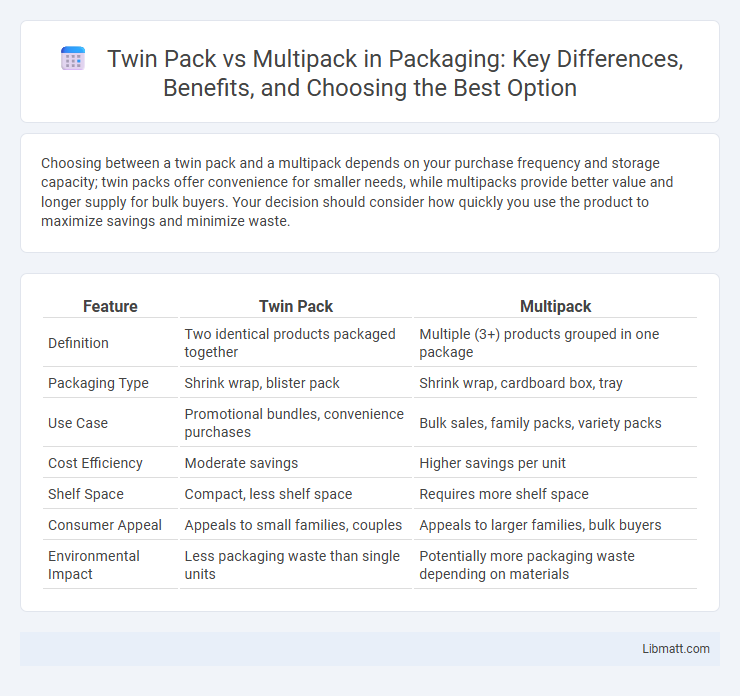Choosing between a twin pack and a multipack depends on your purchase frequency and storage capacity; twin packs offer convenience for smaller needs, while multipacks provide better value and longer supply for bulk buyers. Your decision should consider how quickly you use the product to maximize savings and minimize waste.
Table of Comparison
| Feature | Twin Pack | Multipack |
|---|---|---|
| Definition | Two identical products packaged together | Multiple (3+) products grouped in one package |
| Packaging Type | Shrink wrap, blister pack | Shrink wrap, cardboard box, tray |
| Use Case | Promotional bundles, convenience purchases | Bulk sales, family packs, variety packs |
| Cost Efficiency | Moderate savings | Higher savings per unit |
| Shelf Space | Compact, less shelf space | Requires more shelf space |
| Consumer Appeal | Appeals to small families, couples | Appeals to larger families, bulk buyers |
| Environmental Impact | Less packaging waste than single units | Potentially more packaging waste depending on materials |
Understanding Twin Packs and Multipacks
Twin packs and multipacks both offer convenient purchasing options for consumers, but they differ in quantity and price incentives. A twin pack typically contains two units of the same product, ideal for quick replenishment or trial, while multipacks bundle three or more units, often providing better value per item and encouraging bulk buying. Understanding these packaging options helps consumers optimize savings and storage based on their needs and consumption patterns.
Key Differences Between Twin Packs and Multipacks
Twin packs typically contain two identical products packaged together, offering convenience and slight cost savings per unit. Multipacks include three or more items, often with a mix of flavors or variations, designed for extended use or sharing. Key differences lie in quantity, packaging variety, and pricing structure, affecting consumer purchasing decisions and shelf space efficiency.
Packaging Materials and Sustainability
Twin packs typically use less packaging material per unit compared to multipacks, reducing overall waste and resource consumption. Multipacks often involve additional layers of plastic or cardboard to securely bundle multiple items, which can increase environmental impact. Choosing the right option for Your needs can help minimize packaging waste and support sustainable consumption practices.
Cost Comparison: Twin Pack vs Multipack
Twin packs typically offer lower unit costs compared to single items, making them an economical choice for consumers seeking value in smaller quantities. Multipacks often provide even greater cost savings per unit by bundling larger quantities, which reduces packaging expenses and maximizes discounts. Evaluating price per unit reveals that multipacks generally deliver superior cost efficiency over twin packs, especially for frequent or bulk purchases.
Consumer Convenience and Usability
Twin packs provide consumer convenience by offering a compact, easy-to-store option ideal for small households or quick replenishment. Multipacks enhance usability through bulk purchasing, reducing shopping frequency and ensuring you have sufficient supply for longer periods. Choosing between twin pack and multipack depends on your storage capacity and consumption rate, optimizing convenience based on individual needs.
Shelf Life and Product Freshness
Twin packs offer a shorter shelf life per unit compared to multipacks due to their smaller individual packaging, which is ideal for consumers seeking fresh products consumed quickly. Multipacks maintain product freshness longer by providing multiple sealed portions, reducing exposure to air and contaminants each time a single unit is opened. This extended freshness preservation makes multipacks better suited for families or long-term storage.
Storage and Space Efficiency
Twin packs offer a compact solution, ideal for limited storage spaces by combining two units into a single package, reducing clutter on shelves. Multipacks, while bulkier, provide greater overall quantity and can optimize space efficiency in larger storage areas by consolidating multiple units into one shipment. Your choice depends on balancing available storage capacity with consumption needs, ensuring efficient use of space without compromising accessibility.
Purchasing Trends and Market Demand
Twin packs cater to consumers seeking convenience and value for smaller quantities, often favored for products like personal care and snacks. Multipacks appeal to budget-conscious buyers aiming for bulk purchases, driving significant demand in household staples and beverages. Recent market data reveals a rising preference for multipacks in urban areas, reflecting shifts towards cost-saving and reduced shopping frequency.
Brand Strategies for Twin Packs and Multipacks
Twin packs and multipacks serve distinct brand strategies by targeting different consumer needs and shopping behaviors. Twin packs emphasize value and convenience for frequent purchasers, reinforcing brand loyalty through repeat use, while multipacks leverage bulk purchasing appeal to drive higher sales volume and attract cost-conscious shoppers. Your choice between these pack types can strategically position your brand to maximize market share and meet specific consumer demand segments.
Choosing the Right Option for Your Needs
Twin packs offer convenience and cost savings for individuals or small households by providing two units of the same product in one package, ideal for quick replenishment. Multipacks, containing multiple units often ranging from four to twelve, cater to larger families or frequent users who benefit from bulk purchasing and reduced per-unit prices. Selecting between twin packs and multipacks depends on factors like consumption rate, storage space, and budget preferences to ensure optimal value and convenience.
Twin pack vs multipack Infographic

 libmatt.com
libmatt.com